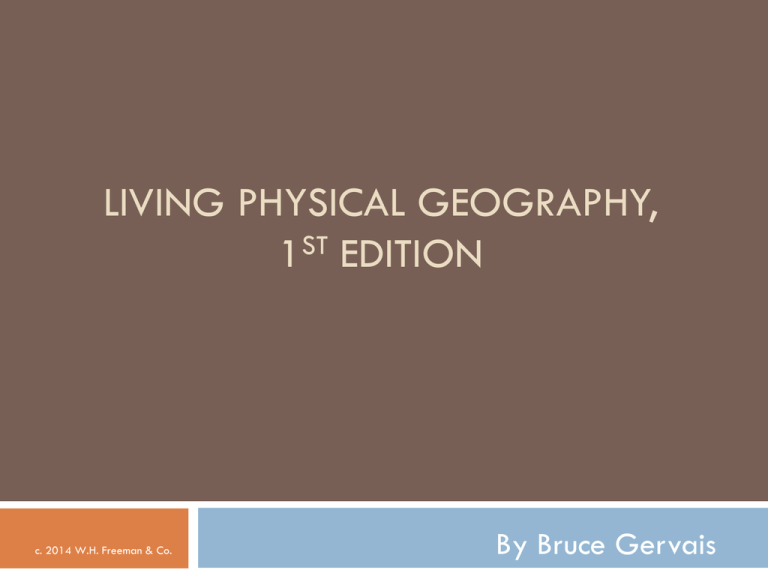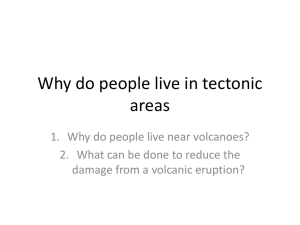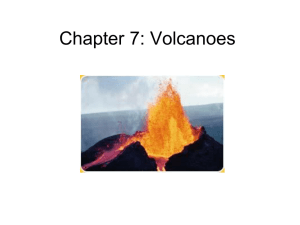chapter 14
advertisement

LIVING PHYSICAL GEOGRAPHY, 1ST EDITION c. 2014 W.H. Freeman & Co. By Bruce Gervais Chapter 14 Geohazards: Volcanoes and Earthquakes Geohazard A hazard posed to people by the physical Earth Examples of Geohazards Volcanic eruptions Landslides Rockfalls Earthquakes Tsunamis Floods Tsunami A large ocean wave triggered by an earthquake or other natural disturbance About Volcanoes Active Volcanoes: Those that have erupted in the last 10,000 years and could erupt again Dormant Volcanoes: Those that have not erupted for 10,000 years or more, but could awaken again Extinct Volcanoes: Those that have not erupted for tens of thousands of years and can never erupt again Three Types of Volcanoes Stratovolcanoes (composite volcanoes) Shield volcanoes Cinder Cones Stratovolcano (composite volcano): A large, potentially explosive cone-shaped volcano composed of alternating layers of lava and pyroclast Pyroclasts, or pyroclastic materials, encompass any fragmented solid material that is ejected from a volcano. Shield Volcano A broad, domed volcano formed from many layers of fluid basaltic lava Shield volcanoes are much larger than stratovolcanoes, and can be difficult to identify as volcanoes from the ground. Shield Volcano Structure Cinder Cone Small, cone-shaped volcanoes consisting of pyroclasts that settle at the angle of repose The angle of repose is the steepest angle at which loose sediments can settle. Cinder Cone Structure Three Types of Volcanic Products Lavas Pyroclasts Gases Lavas Mafic Temperature of about 1,000°C to 1,200°C (1,800°F to 2,200°F) Silica content of 50% or less Low viscosity and flows easily Intermediate Temperature of about 800°C to 1,000°C (1,500°F to 1,800°F) Silica content between 50% and 70% Felsic Medium viscosity Temperature of about 650°C to 800°C (1,200°F to 1,500°F) Silica content of 70% or more High viscosity restricts its ability to flow Lava Viscosities Mafic Lava Types When mafic lava solidifies into smooth, billowy lobes over the surface, it is called Pāhoehoe. When it takes on a blocky, rough surface, it is called ʻAʻā. Lava Lakes Types of Pyroclasts Volcanic ash: Fine volcanic powder consisting of pulverized rock particles and solidified droplets of lava Lapilli: Marble-to golf ball-sized cooled fragments of lava Types of Pyroclasts Pumice: A lightweight, porous rock with at least 50% air content Types of Pyroclasts Volcanic bombs: A streamlined fragment of lava ejected from a volcano that cooled and hardened as it moved through the air Volcanic blocks: A fragment of rock from the volcano’s cone that is ejected during an explosive eruption Volcanic Gases Gas is not a pyroclastic material, but gas emissions produce pyroclasts. As gas forcefully exits a volcano, it blasts lava and rock debris into the air, generating pyroclasts. Volcanic Landforms Volcanic landforms are typically very conspicuous on Earth’s surface. Some common volcanic landforms are volcanic mountains, columnar jointing, large igneous provinces, and calderas. Columnar Jointing A geometric pattern of angular columns that forms from joints in basaltic lava during cooling Large Igneous Province An accumulation of flood basalts that covers an extensive geographic area Caldera A large depression that forms when a volcano’s magma chamber empties and collapses after the volcano erupts Caldera Formation Calderas Two Kinds of Eruptions: Effusive: A nonexplosive eruption that produces mostly lava, (e.g., shield volcanoes) Explosive: An eruption that sends rock, ash, and volcanic gases high into the troposphere, or even into the stratosphere, (e.g., many stratovolcanoes) Ranking Volcano Strength: The Volcanic Explosivity Index (VEI) Ranks volcanic eruption magnitude based on the amount of material a volcano ejects during an eruption Volcanic Intensity Comparison Volcanoes' Two Greatest Threats Lahars Pyroclastic Flows Lahar A thick slurry of mud, ash, water, and other debris that flows rapidly down a snowcapped stratovolcano when it erupts Pyroclastic Flow A rapidly moving avalanche of searing hot gas and ash The Destruction of Pompeii Can Scientists Predict Volcanic Eruptions? Scientists can sometimes predict an eruption within weeks or months if a volcano gives warning signs. The Pacific Ring of Fire More than 60% of the Pacific Ocean’s margins are subduction zones with active and dangerous stratovolcanoes. Although shield volcanoes are found in the Pacific Ring of Fire, explosive stratovolcanoes are the most common type of volcano there. Tectonic Hazards: Faults and Earthquakes Although usually less noticeable than volcanic hazards, earthquakes are as dangerous as volcanoes, or even more so. Three Types of Faults Normal Fault A result of tensional force (extension) as two pieces of Earth’s crust, called fault blocks, are pulled apart Reverse Fault Results from compressional force, which pushes one block upward in relation to another block Strike-Slip Fault Occurs where one block moves horizontally in relation to another block as a result of shearing (lateral) force Three Types of Faults Fault Indicators Reverse and normal faults create a fault scarp, or cliff face, that results from the vertical movement of the fault blocks. Where strike-slip faults cross linear features, those features may be offset by fault movement, (left-lateral and right-lateral). How Do Earthquakes Occur? Earthquakes occur when geologic stress exceeds friction, and the crust breaks (either along a preexisting fault or along a new fault), and the blocks move. As each block moves, the built-up stress energy is released and travels through the crust as seismic waves, resulting in an earthquake. Earthquake Terminology Focus: The location of initial movement along a fault during an earthquake Epicenter: The location on the ground’s surface immediately above the focus of an earthquake, where earthquake intensity is usually greatest Foreshock: A small earthquake that sometimes precedes a larger earthquake Aftershock: A small earthquake that follows the main earthquake Geographic Patterns of Earthquakes a. b. c. d. e. f. g. Most earthquakes occur along plate boundaries in seismic belts. The tectonic settings of earthquakes include: Collision zones Subduction zones Transform plate boundaries Mid-plate earthquakes Continental rifts Hot spots Divergent plate boundaries Seismic Waves Categories of seismic waves based on where waves travel: Body waves pass through the “body” of Earth, (P Waves and S Waves). Surface waves travel near the surface of the crust, (R Waves and L Waves). Seismic Waves Categories of seismic waves based on how waves move: Compressional waves produce movement that goes back and forth in a direction parallel to the direction of the traveling waves. Shear waves move back and forth perpendicular to the direction the waves are traveling. Detecting Earthquakes Earthquake magnitude is determined from measurements of ground movement using seismographs. Seismograph (or seismometer): An instrument used to detect, measure, and record ground shaking Earthquake Intensity The amount of ground shaking caused by an earthquake depends on the earthquake’s magnitude, the distance from its focus, and the composition of the ground being shaken. Earthquake intensity is determined by the amount of damage an earthquake causes to physical structures. The Moment Magnitude Scale An earthquake ranking system based on the amount of ground movement produced Relies on seismographic data to quantify ground movement Takes several weeks to collect data and calculate the moment magnitude scale because scientists have to go out and inspect the ground for indications of the extent of movement Liquefaction Loose, wet sediments are susceptible to liquefaction: the transformation of solid sediments into an unstable slurry by ground shaking. Buildings resting on top of sediments may sink. Earthquake Probabilities Earthquake Damage The World’s Deadliest Volcanoes Particularly notable volcanoes in the Sunda Arc in Indonesia are Krakatau, Toba, and Tambora. Krakatau’s most recent big eruption was in 1883, (a VEI 6 eruption that killed over 36,000 people). Toba’s eruption about 73,000 years ago was one of the largest known volcanic eruptions in Earth’s history, (an estimated VEI 8). Tambora 1815 eruption caused the greatest known human death toll of any volcanic eruption Tambora’s Wide Reach 1816 was nicknamed the “year without a summer”, because it was unusually cold in both eastern North America and in northern Europe.








